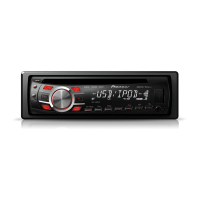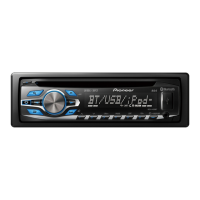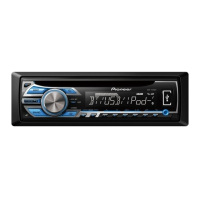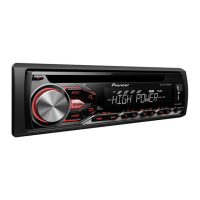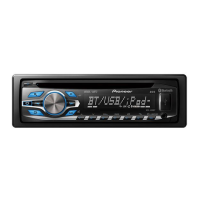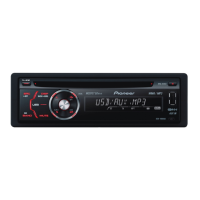What to do if my Pioneer Car Receiver shows ERROR-11 or ERROR-12?
- BBrett ObrienAug 1, 2025
If your Pioneer Car Receiver displays ERROR-11 or ERROR-12, it means the disc is dirty. You should clean the disc to resolve this issue.
What to do if my Pioneer Car Receiver shows ERROR-11 or ERROR-12?
If your Pioneer Car Receiver displays ERROR-11 or ERROR-12, it means the disc is dirty. You should clean the disc to resolve this issue.
What to do if my Pioneer DEH-4350UB Car Receiver displays ERROR-23?
If your Pioneer Car Receiver shows ERROR-23, the disc format is not supported. You should replace the disc with one that is compatible.
What to do if my Pioneer Car Receiver displays ERROR-15?
If your Pioneer Car Receiver is showing ERROR-15, it means the inserted disc is blank. Replace the disc with a valid one.
What to do if my Pioneer Car Receiver won't play a disc because it is scratched?
If your Pioneer Car Receiver is having trouble playing a disc and you suspect it's due to scratches, you should replace the disc.
General information about the unit.
Covers CAUTIONs, Demo mode, and Important notes.
Diagram and description of the main unit's buttons.
Diagram and description of the remote control's buttons.
Explanation of symbols on the unit's display.
Core functions like turning on/off, source selection, and volume.
Instructions for using and maintaining the remote.
Important warnings and cautions regarding battery and unit handling.
How to move through the unit's menus and settings.
Basic functions for radio tuning and station management.
Playing music from CDs and USB devices.
Special features like repeat, random, and sound retriever.
Enhancing audio quality for compressed files.
Accessing and modifying audio settings like fader, balance, equalizer.
Adjusting volume levels for different audio sources.
Setting up basic functions like clock, tuning steps, and auxiliary input.
Configuring USB plug-and-play and iPod control modes.
SW Control and DEMO mode settings.
Adjusting display colors.
Connecting and using the auxiliary input.
Turning the clock display on or off.
Wiring diagram and connection instructions.
Important precautions during installation.
Details on power, speaker, subwoofer, and amplifier wiring.
Important safety and functional checks.
How to install the unit using DIN front or rear mounting.
Steps for unit removal and mounting.
Procedures for removing and re-attaching the front panel.
General supplemental details.
Common problems and their solutions.
Further details on error messages and handling guidelines.
Best practices for discs, players, and USB devices.
Details on iPod, DualDiscs, and audio file compatibility.
Supported iPod models and software versions.
Details on disc and USB playback hierarchy and file naming conventions.
Copyrights and trademarks for various audio formats and brands.
Technical details of the unit's components and features.
Technical details for tuner, remote control, and general specs.
Technical specifications for USB, FM/AM tuner, and remote control.
Solutions for common error messages related to CD, USB, and iPod.
Best practices for discs and players.
Steps for unit removal and mounting.
Procedures for removing and re-attaching the front panel.
Error messages and solutions for CD, USB, and iPod.
Steps for unit removal and mounting.
Procedures for removing and re-attaching the front panel.
Error messages and solutions for CD, USB, and iPod.
Covers SW Control, DEMO, SCROLL, illumination color, AUX, and clock settings.
General safety and functional checks.
Explains Repeat, Random, Pause, and Sound Retriever functions.
Details on Fader/Balance, Equalizer, Tone, Loudness, and Subwoofer settings.
Adjusting volume levels for different audio sources.
How to select and play files/tracks from lists.
Basic and advanced operations for iPod connectivity.
Information on supported iPod models.
Detailed explanation of iPod functions like repeat, shuffle, link play, and control modes.
Setting Repeat, Shuffle, Link Play, Pause, and Audio Book functions.
Overview of the main unit and remote control buttons.
How to use the unit for source selection, volume adjustment, and display control.
General information and safety warnings.
Key points regarding demo mode and battery drain.
Details on file hierarchy, copyrights, and specifications.
Technical details for audio, CD player, and general specs.
Details on USB, iPod, DualDisc, and audio file compatibility.
Information on playback hierarchy and file naming conventions.
Common error messages and solutions for CD, USB, and iPod.
Best practices for discs and players.
Steps for unit removal and mounting.
Procedures for removing and re-attaching the front panel.
Error messages and solutions for CD, USB, and iPod.
Details on power, speaker, subwoofer, and amplifier wiring.
DIN front and rear mounting instructions.
Covers SW Control, DEMO, SCROLL, illumination color, AUX, and clock settings.
Explains Repeat, Random, Pause, and Sound Retriever functions.
Details on Fader/Balance, Equalizer, Tone, Loudness, and Subwoofer settings.
Adjusting volume levels for different audio sources.
Setting Repeat, Shuffle, Link Play, Pause, and Audio Book functions.
Basic and advanced operations for iPod connectivity.
How to move through the unit's menus and settings.
Basic functions for radio tuning and station management.
Playing music from CDs and USB devices.
Special features like repeat, random, and sound retriever.
Explanation of symbols on the unit's display.
Core functions like turning on/off, source selection, and volume.
Instructions for using and maintaining the remote.
Important warnings and cautions regarding battery and unit handling.
General information and safety warnings.
Key points regarding demo mode and battery drain.
| Model | DEH-4350UB |
|---|---|
| DIN Size | 1 DIN |
| Channels | 4 |
| Max Power Output | 50W x 4 |
| Tuner | AM/FM |
| CD Playback | Yes |
| MP3 Playback | Yes |
| WMA Playback | Yes |
| AAC Playback | Yes |
| USB Input | Yes |
| USB Direct Control for iPod/iPhone | Yes |
| Aux Input | Yes |
| Bluetooth | No |
| Display Type | LCD |
| Display Color | Blue |
| Button Color | Blue |
| Equalizer | Yes |
| EQ Bands | 5 |
| High-Pass Crossover | Yes |
| Low-Pass Crossover | Yes |
| Subwoofer Output | Yes |
| Preamp Output Voltage | 2V |
| Detachable Face | Yes |
| Remote Control | Yes |
| Preamp Outputs | 3 |
| RMS Power Output | 22 Watts x 4 |
